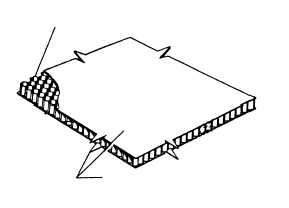METALLIC MATERIALS
The most common metals used in aircraft
construction are aluminum, magnesium, titanium,
steel, and their alloys.
Aluminum
Aluminum alloys are widely used in modern
aircraft construction. Aluminum alloys are valuable
because they have a high strength-to-weight ratio.
Aluminum
alloys
are
corrosion
resistant
and
comparatively easy to fabricate. The outstanding
characteristic of aluminum is its lightweight.
Magnesium
Magnesium is the world's lightest structural metal.
It is a silvery-white material that weighs two-thirds as
much as aluminum. Magnesium is used to make
helicopters. Magnesium's low resistance to corrosion
has limited its use in conventional aircraft.
Titanium
Titanium is a lightweight, strong, corrosion-
resistant metal. Recent developments make titanium
ideal for applications where aluminum alloys are too
weak and stainless steel is too heavy. Additionally,
titanium is unaffected by long exposure to seawater and
marine atmosphere.
Alloys
An alloy is composed of two or more metals. The
metal present in the alloy in the largest amount is called
the base metal. All other metals added to the base metal
are called
alloying elements. Adding the alloying
elements may result in a change in the properties of the
base metal. For example, pure aluminum is relatively
soft and weak. However, adding small amounts or
copper, manganese, and magnesium will increase
aluminum's strength many times. Heat treatment can
increase or decrease an alloy's strength and hardness.
Alloys are important to the aircraft industry. They
provide materials with properties that pure metals do
not possess.
Steel Alloys
Alloy steels used in aircraft construction have great
strength, more so than other fields of engineering would
require. These materials must withstand the forces that
occur on today's modern aircraft. These steels contain
small percentages of carbon, nickel, chromium,
vanadium, and molybdenum. High-tensile steels will
stand stress of 50 to 150 tons per square inch without
failing. Such steels are made into tubes, rods, and wires.
Another type of steel used extensively is stainless
steel. Stainless steel resists corrosion and is particularly
valuable for use in or near water.
NONMETALLIC MATERIALS
In addition to metals, various types of plastic
materials are found in aircraft construction. Some of
these plastics include transparent plastic, reinforced
plastic, composite, and carbon-fiber materials.
Transparent Plastic
Transparent
plastic
is
used
in
canopies,
windshields, and other transparent enclosures. You
need to handle transparent plastic surfaces carefully
because they are relatively soft and scratch easily. At
approximately 225°F, transparent plastic becomes soft
and pliable.
Reinforced Plastic
Reinforced plastic is used in the construction of
radomes, wingtips, stabilizer tips, antenna covers, and
flight
controls.
Reinforced
plastic
has
a
high
strength-to-weight ratio and is resistant to mildew and
rot. Because it is easy to fabricate, it is equally suitable
for other parts of the aircraft.
Reinforced plastic is a sandwich-type material (fig.
4-4). It is made up of two outer facings and a center
layer. The facings are made up of several layers of glass
cloth, bonded together with a liquid resin. The core
material (center layer) consists of a honeycomb
4-4
HONEYCOMB
CORE
FACINGS
(MULTIPLE LAYERS OF GLASS CLOTH)
Anf0404
Figure 4-4.—Reinforced plastic.


